Program Plan and Evaluation: Healthcare for Aboriginal Australians
VerifiedAdded on 2023/06/03
|19
|4633
|106
Report
AI Summary
This report examines the barriers to healthcare access faced by Aboriginal and Torres Strait Islander people in Australia, highlighting the disparities in life expectancy and healthcare access compared to non-indigenous Australians. It identifies key issues such as geographical remoteness, socioeconomic status, literacy, education, and inadequate government support as significant factors contributing to these barriers. The report includes a community needs assessment, stakeholder analysis, and a proposed program plan aimed at improving healthcare accessibility through increased geographical distribution of health services, addressing employment and socioeconomic factors, promoting literacy and education, and advocating for greater government support. The report also touches upon the Ottawa Charter Strategies and provides recommendations to maximize healthcare accessibility for Aboriginal and Torres Strait Islander communities, aiming to reduce the gap in health outcomes and promote equality.

Running head: PROGRAM PLAN AND EVALUATION IN PUBLIC HEALTH 1
Barriers to Access to Healthcare for Aboriginal and Torres Strait Islanders People
(Student’s name)
(Institutional Affiliation)
Barriers to Access to Healthcare for Aboriginal and Torres Strait Islanders People
(Student’s name)
(Institutional Affiliation)
Paraphrase This Document
Need a fresh take? Get an instant paraphrase of this document with our AI Paraphraser
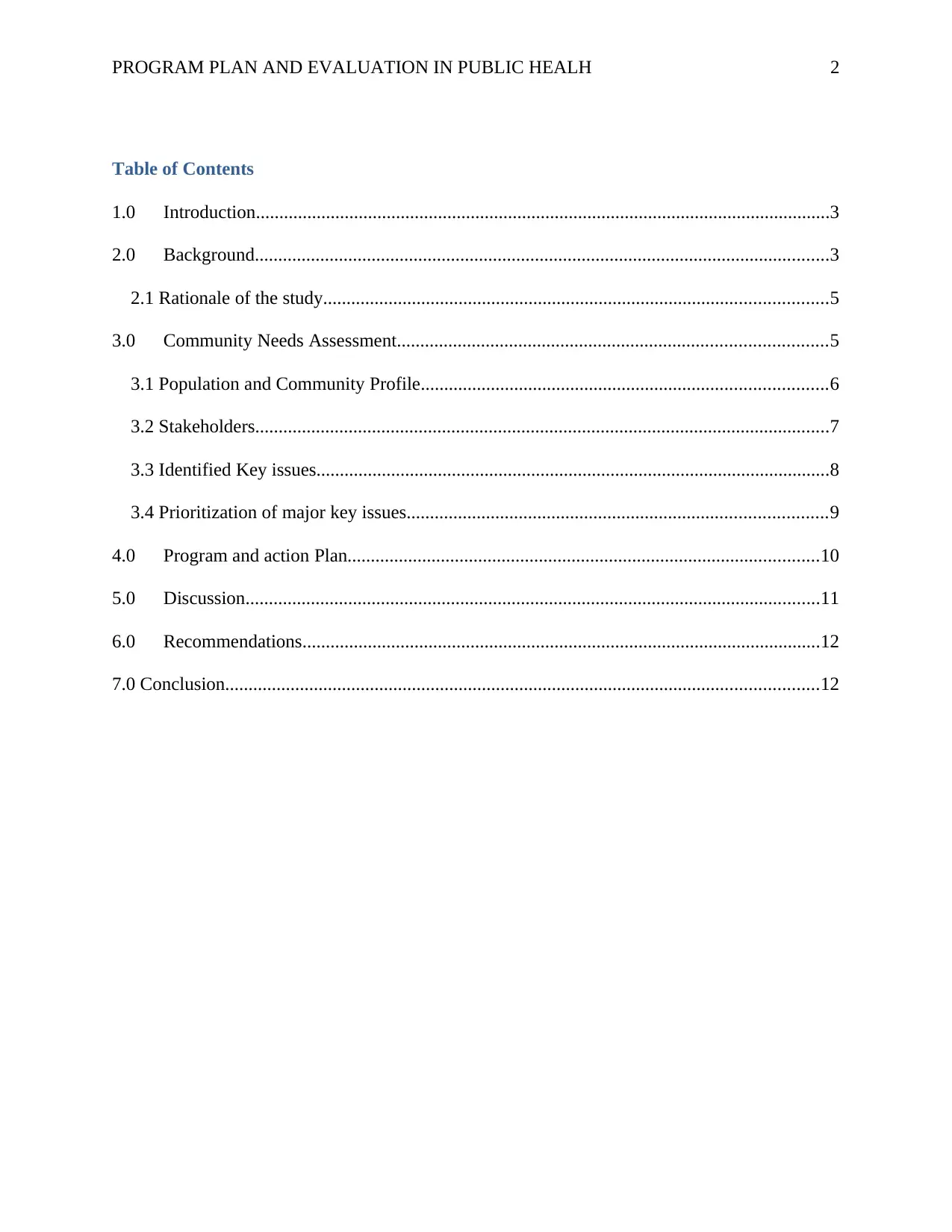
PROGRAM PLAN AND EVALUATION IN PUBLIC HEALH 2
Table of Contents
1.0 Introduction...........................................................................................................................3
2.0 Background...........................................................................................................................3
2.1 Rationale of the study............................................................................................................5
3.0 Community Needs Assessment............................................................................................5
3.1 Population and Community Profile.......................................................................................6
3.2 Stakeholders...........................................................................................................................7
3.3 Identified Key issues..............................................................................................................8
3.4 Prioritization of major key issues..........................................................................................9
4.0 Program and action Plan.....................................................................................................10
5.0 Discussion...........................................................................................................................11
6.0 Recommendations...............................................................................................................12
7.0 Conclusion...............................................................................................................................12
Table of Contents
1.0 Introduction...........................................................................................................................3
2.0 Background...........................................................................................................................3
2.1 Rationale of the study............................................................................................................5
3.0 Community Needs Assessment............................................................................................5
3.1 Population and Community Profile.......................................................................................6
3.2 Stakeholders...........................................................................................................................7
3.3 Identified Key issues..............................................................................................................8
3.4 Prioritization of major key issues..........................................................................................9
4.0 Program and action Plan.....................................................................................................10
5.0 Discussion...........................................................................................................................11
6.0 Recommendations...............................................................................................................12
7.0 Conclusion...............................................................................................................................12
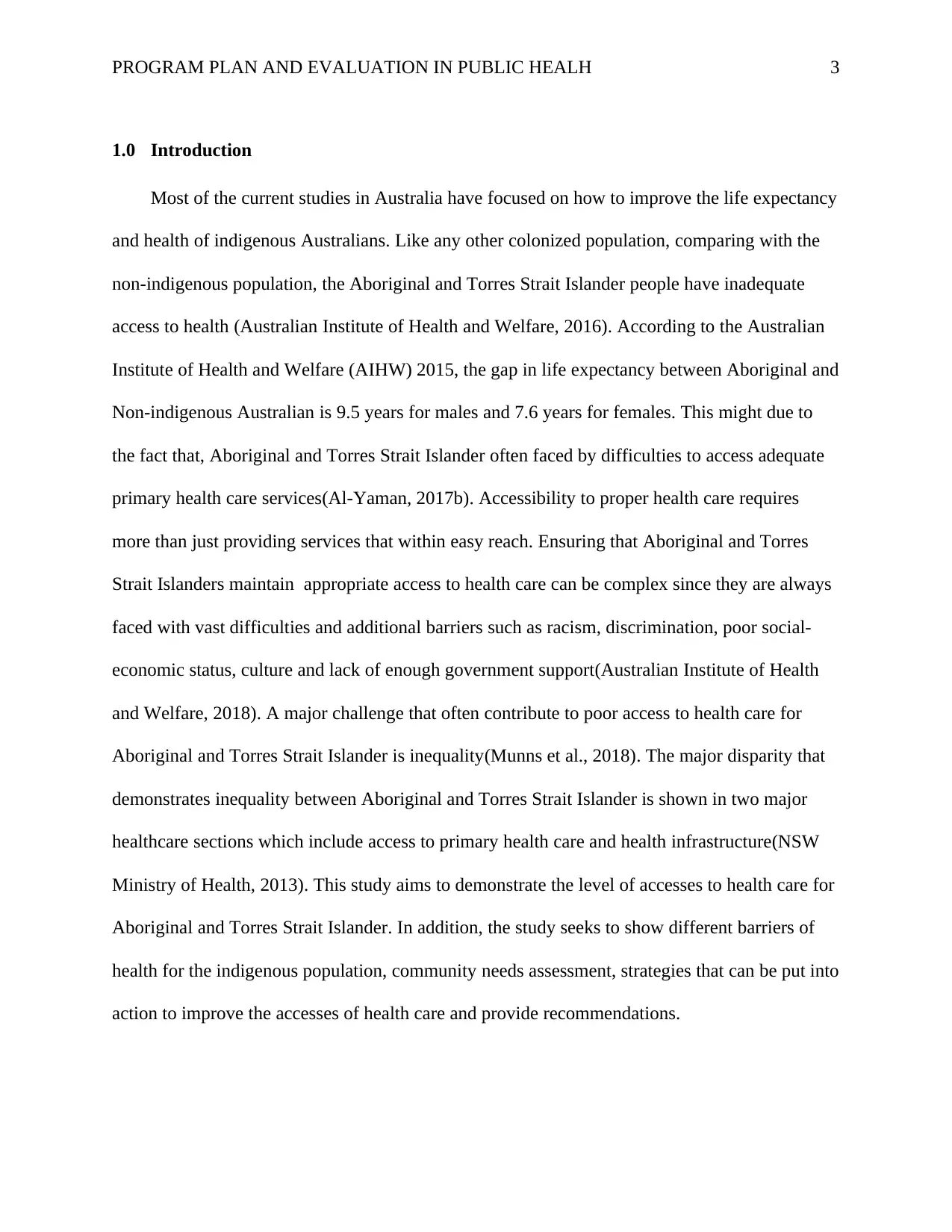
PROGRAM PLAN AND EVALUATION IN PUBLIC HEALH 3
1.0 Introduction
Most of the current studies in Australia have focused on how to improve the life expectancy
and health of indigenous Australians. Like any other colonized population, comparing with the
non-indigenous population, the Aboriginal and Torres Strait Islander people have inadequate
access to health (Australian Institute of Health and Welfare, 2016). According to the Australian
Institute of Health and Welfare (AIHW) 2015, the gap in life expectancy between Aboriginal and
Non-indigenous Australian is 9.5 years for males and 7.6 years for females. This might due to
the fact that, Aboriginal and Torres Strait Islander often faced by difficulties to access adequate
primary health care services(Al-Yaman, 2017b). Accessibility to proper health care requires
more than just providing services that within easy reach. Ensuring that Aboriginal and Torres
Strait Islanders maintain appropriate access to health care can be complex since they are always
faced with vast difficulties and additional barriers such as racism, discrimination, poor social-
economic status, culture and lack of enough government support(Australian Institute of Health
and Welfare, 2018). A major challenge that often contribute to poor access to health care for
Aboriginal and Torres Strait Islander is inequality(Munns et al., 2018). The major disparity that
demonstrates inequality between Aboriginal and Torres Strait Islander is shown in two major
healthcare sections which include access to primary health care and health infrastructure(NSW
Ministry of Health, 2013). This study aims to demonstrate the level of accesses to health care for
Aboriginal and Torres Strait Islander. In addition, the study seeks to show different barriers of
health for the indigenous population, community needs assessment, strategies that can be put into
action to improve the accesses of health care and provide recommendations.
1.0 Introduction
Most of the current studies in Australia have focused on how to improve the life expectancy
and health of indigenous Australians. Like any other colonized population, comparing with the
non-indigenous population, the Aboriginal and Torres Strait Islander people have inadequate
access to health (Australian Institute of Health and Welfare, 2016). According to the Australian
Institute of Health and Welfare (AIHW) 2015, the gap in life expectancy between Aboriginal and
Non-indigenous Australian is 9.5 years for males and 7.6 years for females. This might due to
the fact that, Aboriginal and Torres Strait Islander often faced by difficulties to access adequate
primary health care services(Al-Yaman, 2017b). Accessibility to proper health care requires
more than just providing services that within easy reach. Ensuring that Aboriginal and Torres
Strait Islanders maintain appropriate access to health care can be complex since they are always
faced with vast difficulties and additional barriers such as racism, discrimination, poor social-
economic status, culture and lack of enough government support(Australian Institute of Health
and Welfare, 2018). A major challenge that often contribute to poor access to health care for
Aboriginal and Torres Strait Islander is inequality(Munns et al., 2018). The major disparity that
demonstrates inequality between Aboriginal and Torres Strait Islander is shown in two major
healthcare sections which include access to primary health care and health infrastructure(NSW
Ministry of Health, 2013). This study aims to demonstrate the level of accesses to health care for
Aboriginal and Torres Strait Islander. In addition, the study seeks to show different barriers of
health for the indigenous population, community needs assessment, strategies that can be put into
action to improve the accesses of health care and provide recommendations.
⊘ This is a preview!⊘
Do you want full access?
Subscribe today to unlock all pages.

Trusted by 1+ million students worldwide
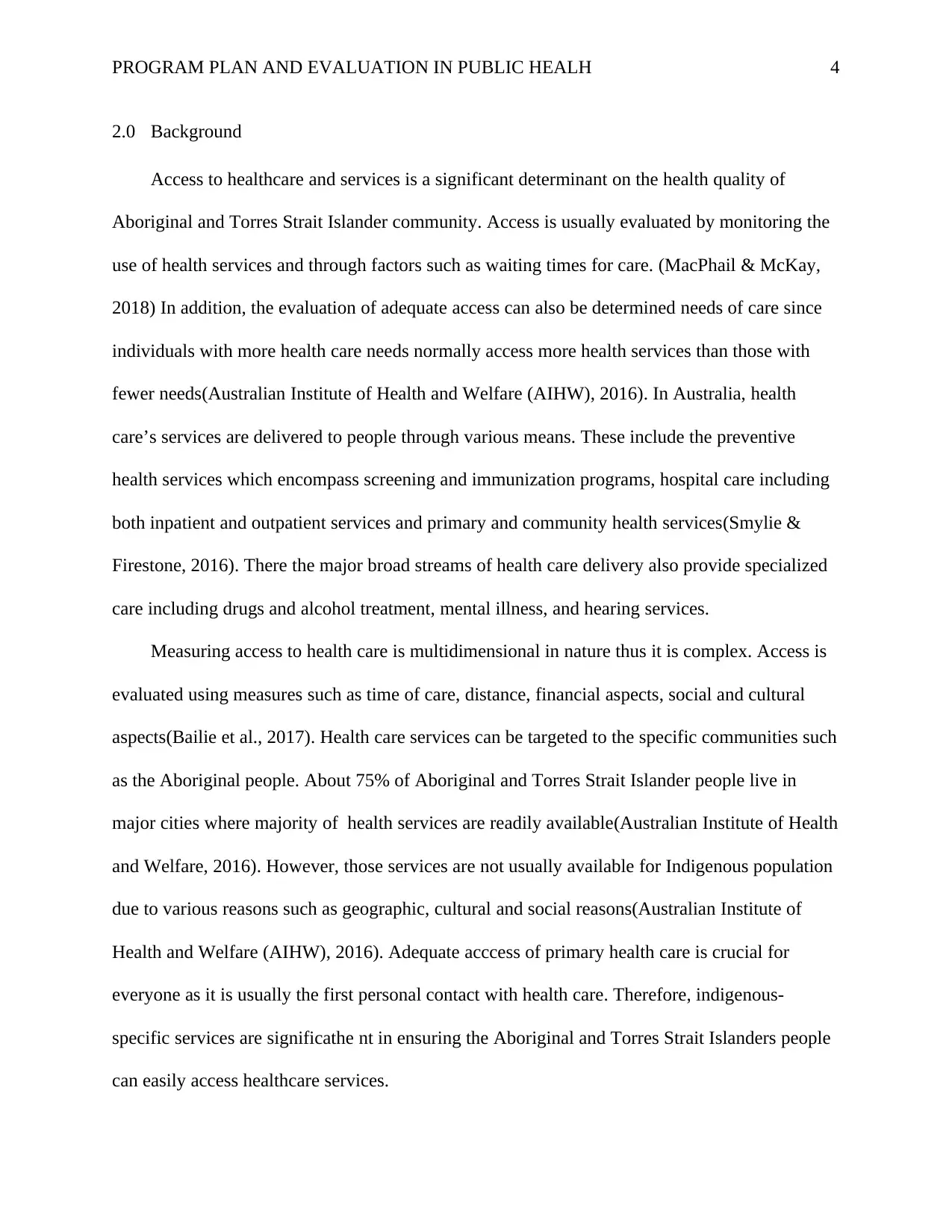
PROGRAM PLAN AND EVALUATION IN PUBLIC HEALH 4
2.0 Background
Access to healthcare and services is a significant determinant on the health quality of
Aboriginal and Torres Strait Islander community. Access is usually evaluated by monitoring the
use of health services and through factors such as waiting times for care. (MacPhail & McKay,
2018) In addition, the evaluation of adequate access can also be determined needs of care since
individuals with more health care needs normally access more health services than those with
fewer needs(Australian Institute of Health and Welfare (AIHW), 2016). In Australia, health
care’s services are delivered to people through various means. These include the preventive
health services which encompass screening and immunization programs, hospital care including
both inpatient and outpatient services and primary and community health services(Smylie &
Firestone, 2016). There the major broad streams of health care delivery also provide specialized
care including drugs and alcohol treatment, mental illness, and hearing services.
Measuring access to health care is multidimensional in nature thus it is complex. Access is
evaluated using measures such as time of care, distance, financial aspects, social and cultural
aspects(Bailie et al., 2017). Health care services can be targeted to the specific communities such
as the Aboriginal people. About 75% of Aboriginal and Torres Strait Islander people live in
major cities where majority of health services are readily available(Australian Institute of Health
and Welfare, 2016). However, those services are not usually available for Indigenous population
due to various reasons such as geographic, cultural and social reasons(Australian Institute of
Health and Welfare (AIHW), 2016). Adequate acccess of primary health care is crucial for
everyone as it is usually the first personal contact with health care. Therefore, indigenous-
specific services are significathe nt in ensuring the Aboriginal and Torres Strait Islanders people
can easily access healthcare services.
2.0 Background
Access to healthcare and services is a significant determinant on the health quality of
Aboriginal and Torres Strait Islander community. Access is usually evaluated by monitoring the
use of health services and through factors such as waiting times for care. (MacPhail & McKay,
2018) In addition, the evaluation of adequate access can also be determined needs of care since
individuals with more health care needs normally access more health services than those with
fewer needs(Australian Institute of Health and Welfare (AIHW), 2016). In Australia, health
care’s services are delivered to people through various means. These include the preventive
health services which encompass screening and immunization programs, hospital care including
both inpatient and outpatient services and primary and community health services(Smylie &
Firestone, 2016). There the major broad streams of health care delivery also provide specialized
care including drugs and alcohol treatment, mental illness, and hearing services.
Measuring access to health care is multidimensional in nature thus it is complex. Access is
evaluated using measures such as time of care, distance, financial aspects, social and cultural
aspects(Bailie et al., 2017). Health care services can be targeted to the specific communities such
as the Aboriginal people. About 75% of Aboriginal and Torres Strait Islander people live in
major cities where majority of health services are readily available(Australian Institute of Health
and Welfare, 2016). However, those services are not usually available for Indigenous population
due to various reasons such as geographic, cultural and social reasons(Australian Institute of
Health and Welfare (AIHW), 2016). Adequate acccess of primary health care is crucial for
everyone as it is usually the first personal contact with health care. Therefore, indigenous-
specific services are significathe nt in ensuring the Aboriginal and Torres Strait Islanders people
can easily access healthcare services.
Paraphrase This Document
Need a fresh take? Get an instant paraphrase of this document with our AI Paraphraser

PROGRAM PLAN AND EVALUATION IN PUBLIC HEALH 5
Identifying all barriers of access to health care for indigenous people can be crucial in
making policy decisions and planning for healthcare(Welfare, 2015). The AIWH has revealed
various geographical areas where gaps still exist for the Aboriginal and Torres Strait Islanders.
Majority of these areas are located in Western Australia and Queensland. The relative
distribution of both human and capital resources is poor in these areas(AIHW, 2017). This form
one of the major barrier to access to health for the indigenous community(Australian Institute of
Health and Welfare, 2018). Vast of both communicable and noncommunicable diseases are
common which had led to poor personal health and life expectancy.
2.1 Rationale of the study
It is commonly known that the causes of injuries and illness for a given group of people
are from personal, social and environmental factors. However, the healthcare systems assist in
the treatment and prevention of illnesses as guided by human rights and policies(Spurling,
Askew, Schluter, & Hayman, 2013). The healthcare provides immediate response to chronic and
acute illnesses, protect people’s health through screening and early interventions(Australian
Institute of Health and Welfare (AIHW)., 2016). Evidence shows that timely health care delivery
can increase the life expectancy for the indigenous community(Australian Institute of Health and
Welfare, 2014). Barriers in health care access to the indigenous population can lead to inequality
in health status. Therefore, determining the barriers to access and strategies required to close
such barriers is important as it helps in reducing the gap in life expectancy and making new
policies.
Identifying all barriers of access to health care for indigenous people can be crucial in
making policy decisions and planning for healthcare(Welfare, 2015). The AIWH has revealed
various geographical areas where gaps still exist for the Aboriginal and Torres Strait Islanders.
Majority of these areas are located in Western Australia and Queensland. The relative
distribution of both human and capital resources is poor in these areas(AIHW, 2017). This form
one of the major barrier to access to health for the indigenous community(Australian Institute of
Health and Welfare, 2018). Vast of both communicable and noncommunicable diseases are
common which had led to poor personal health and life expectancy.
2.1 Rationale of the study
It is commonly known that the causes of injuries and illness for a given group of people
are from personal, social and environmental factors. However, the healthcare systems assist in
the treatment and prevention of illnesses as guided by human rights and policies(Spurling,
Askew, Schluter, & Hayman, 2013). The healthcare provides immediate response to chronic and
acute illnesses, protect people’s health through screening and early interventions(Australian
Institute of Health and Welfare (AIHW)., 2016). Evidence shows that timely health care delivery
can increase the life expectancy for the indigenous community(Australian Institute of Health and
Welfare, 2014). Barriers in health care access to the indigenous population can lead to inequality
in health status. Therefore, determining the barriers to access and strategies required to close
such barriers is important as it helps in reducing the gap in life expectancy and making new
policies.
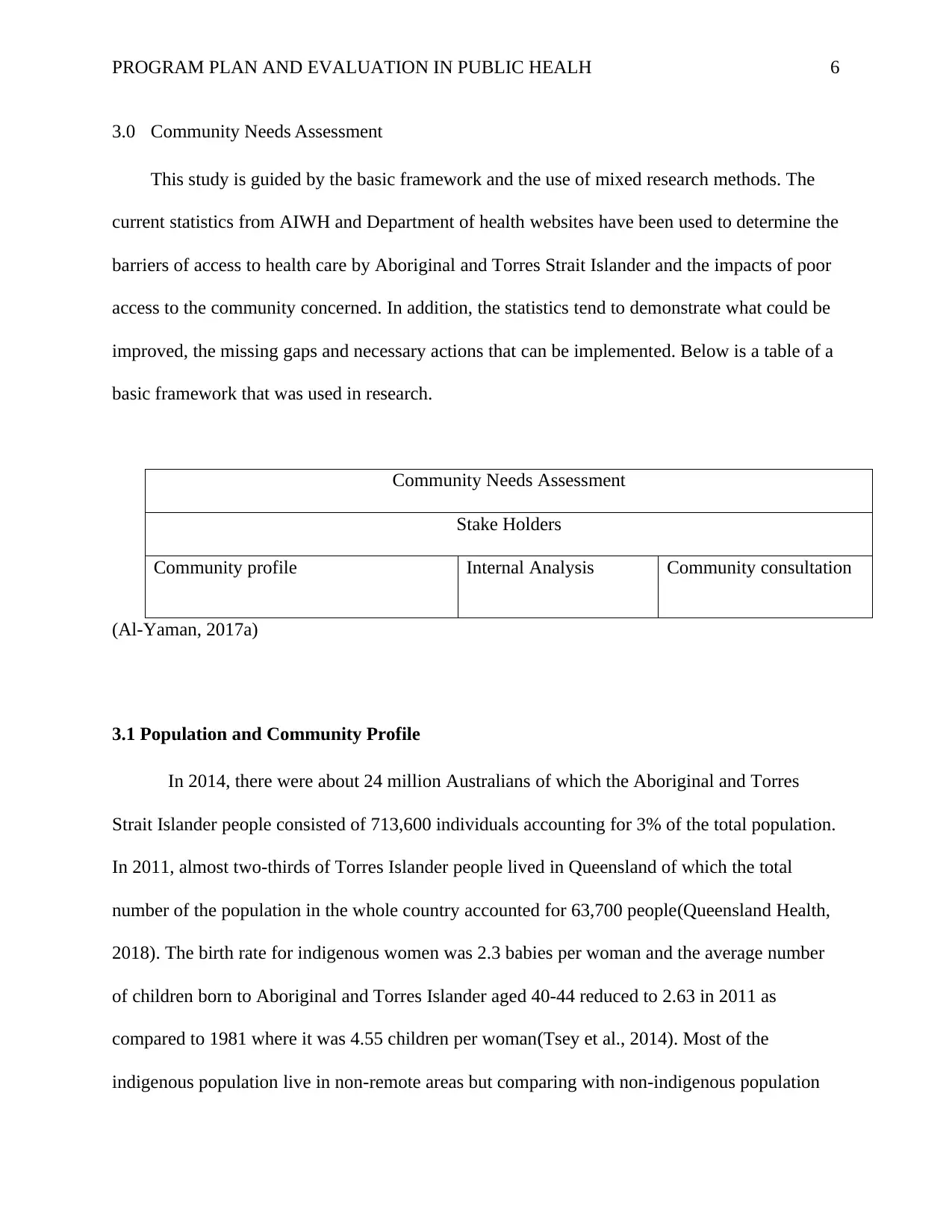
PROGRAM PLAN AND EVALUATION IN PUBLIC HEALH 6
3.0 Community Needs Assessment
This study is guided by the basic framework and the use of mixed research methods. The
current statistics from AIWH and Department of health websites have been used to determine the
barriers of access to health care by Aboriginal and Torres Strait Islander and the impacts of poor
access to the community concerned. In addition, the statistics tend to demonstrate what could be
improved, the missing gaps and necessary actions that can be implemented. Below is a table of a
basic framework that was used in research.
Community Needs Assessment
Stake Holders
Community profile Internal Analysis Community consultation
(Al-Yaman, 2017a)
3.1 Population and Community Profile
In 2014, there were about 24 million Australians of which the Aboriginal and Torres
Strait Islander people consisted of 713,600 individuals accounting for 3% of the total population.
In 2011, almost two-thirds of Torres Islander people lived in Queensland of which the total
number of the population in the whole country accounted for 63,700 people(Queensland Health,
2018). The birth rate for indigenous women was 2.3 babies per woman and the average number
of children born to Aboriginal and Torres Islander aged 40-44 reduced to 2.63 in 2011 as
compared to 1981 where it was 4.55 children per woman(Tsey et al., 2014). Most of the
indigenous population live in non-remote areas but comparing with non-indigenous population
3.0 Community Needs Assessment
This study is guided by the basic framework and the use of mixed research methods. The
current statistics from AIWH and Department of health websites have been used to determine the
barriers of access to health care by Aboriginal and Torres Strait Islander and the impacts of poor
access to the community concerned. In addition, the statistics tend to demonstrate what could be
improved, the missing gaps and necessary actions that can be implemented. Below is a table of a
basic framework that was used in research.
Community Needs Assessment
Stake Holders
Community profile Internal Analysis Community consultation
(Al-Yaman, 2017a)
3.1 Population and Community Profile
In 2014, there were about 24 million Australians of which the Aboriginal and Torres
Strait Islander people consisted of 713,600 individuals accounting for 3% of the total population.
In 2011, almost two-thirds of Torres Islander people lived in Queensland of which the total
number of the population in the whole country accounted for 63,700 people(Queensland Health,
2018). The birth rate for indigenous women was 2.3 babies per woman and the average number
of children born to Aboriginal and Torres Islander aged 40-44 reduced to 2.63 in 2011 as
compared to 1981 where it was 4.55 children per woman(Tsey et al., 2014). Most of the
indigenous population live in non-remote areas but comparing with non-indigenous population
⊘ This is a preview!⊘
Do you want full access?
Subscribe today to unlock all pages.

Trusted by 1+ million students worldwide
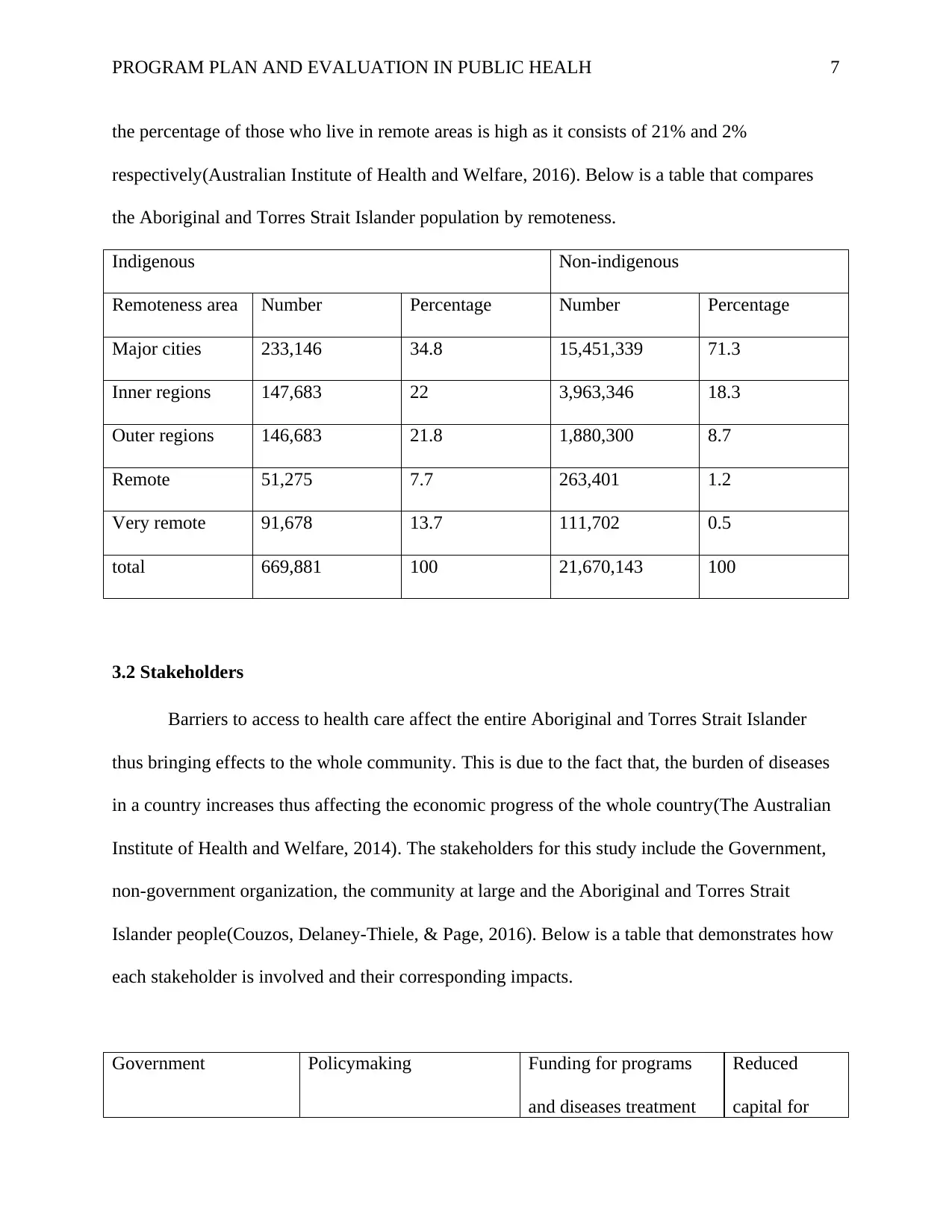
PROGRAM PLAN AND EVALUATION IN PUBLIC HEALH 7
the percentage of those who live in remote areas is high as it consists of 21% and 2%
respectively(Australian Institute of Health and Welfare, 2016). Below is a table that compares
the Aboriginal and Torres Strait Islander population by remoteness.
Indigenous Non-indigenous
Remoteness area Number Percentage Number Percentage
Major cities 233,146 34.8 15,451,339 71.3
Inner regions 147,683 22 3,963,346 18.3
Outer regions 146,683 21.8 1,880,300 8.7
Remote 51,275 7.7 263,401 1.2
Very remote 91,678 13.7 111,702 0.5
total 669,881 100 21,670,143 100
3.2 Stakeholders
Barriers to access to health care affect the entire Aboriginal and Torres Strait Islander
thus bringing effects to the whole community. This is due to the fact that, the burden of diseases
in a country increases thus affecting the economic progress of the whole country(The Australian
Institute of Health and Welfare, 2014). The stakeholders for this study include the Government,
non-government organization, the community at large and the Aboriginal and Torres Strait
Islander people(Couzos, Delaney-Thiele, & Page, 2016). Below is a table that demonstrates how
each stakeholder is involved and their corresponding impacts.
Government Policymaking Funding for programs
and diseases treatment
Reduced
capital for
the percentage of those who live in remote areas is high as it consists of 21% and 2%
respectively(Australian Institute of Health and Welfare, 2016). Below is a table that compares
the Aboriginal and Torres Strait Islander population by remoteness.
Indigenous Non-indigenous
Remoteness area Number Percentage Number Percentage
Major cities 233,146 34.8 15,451,339 71.3
Inner regions 147,683 22 3,963,346 18.3
Outer regions 146,683 21.8 1,880,300 8.7
Remote 51,275 7.7 263,401 1.2
Very remote 91,678 13.7 111,702 0.5
total 669,881 100 21,670,143 100
3.2 Stakeholders
Barriers to access to health care affect the entire Aboriginal and Torres Strait Islander
thus bringing effects to the whole community. This is due to the fact that, the burden of diseases
in a country increases thus affecting the economic progress of the whole country(The Australian
Institute of Health and Welfare, 2014). The stakeholders for this study include the Government,
non-government organization, the community at large and the Aboriginal and Torres Strait
Islander people(Couzos, Delaney-Thiele, & Page, 2016). Below is a table that demonstrates how
each stakeholder is involved and their corresponding impacts.
Government Policymaking Funding for programs
and diseases treatment
Reduced
capital for
Paraphrase This Document
Need a fresh take? Get an instant paraphrase of this document with our AI Paraphraser
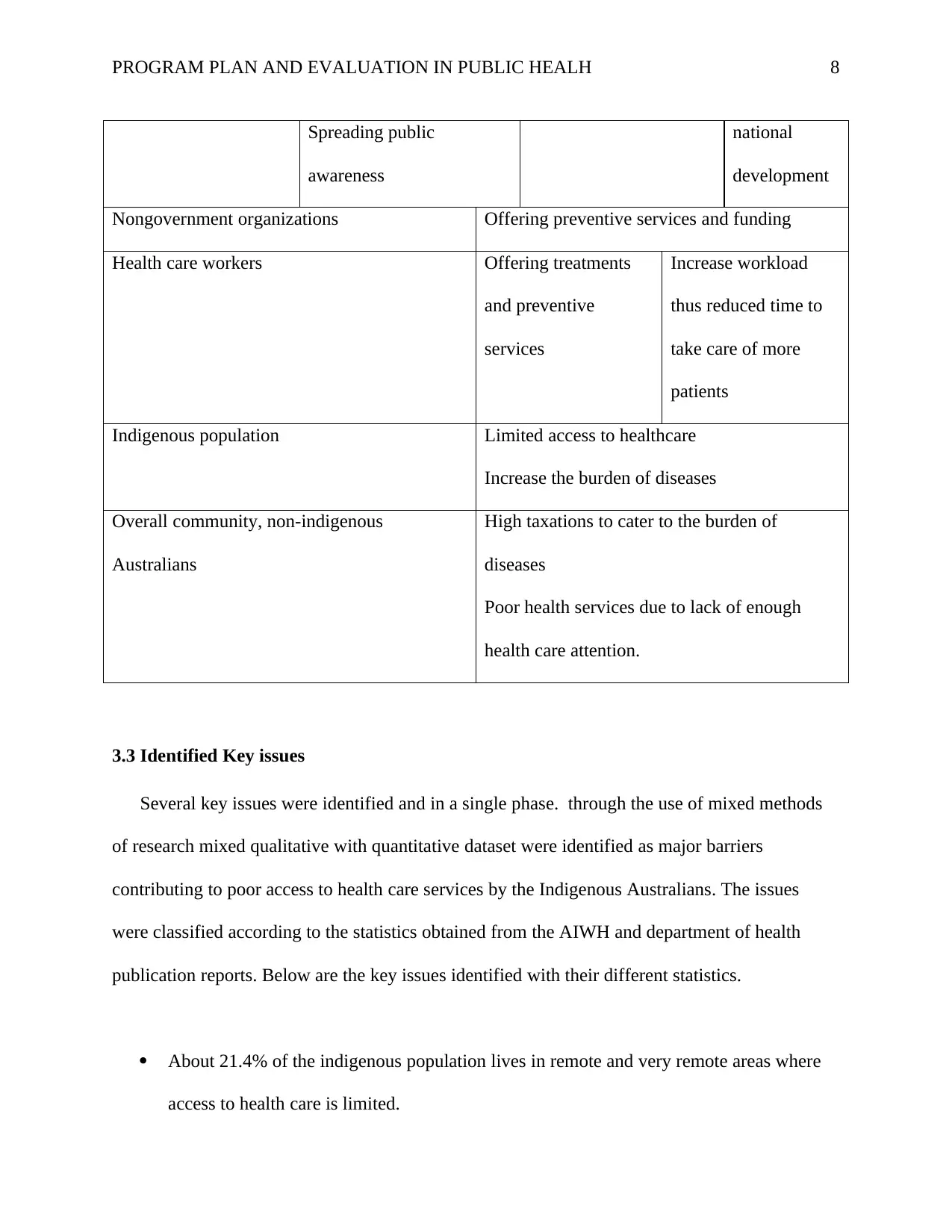
PROGRAM PLAN AND EVALUATION IN PUBLIC HEALH 8
Spreading public
awareness
national
development
Nongovernment organizations Offering preventive services and funding
Health care workers Offering treatments
and preventive
services
Increase workload
thus reduced time to
take care of more
patients
Indigenous population Limited access to healthcare
Increase the burden of diseases
Overall community, non-indigenous
Australians
High taxations to cater to the burden of
diseases
Poor health services due to lack of enough
health care attention.
3.3 Identified Key issues
Several key issues were identified and in a single phase. through the use of mixed methods
of research mixed qualitative with quantitative dataset were identified as major barriers
contributing to poor access to health care services by the Indigenous Australians. The issues
were classified according to the statistics obtained from the AIWH and department of health
publication reports. Below are the key issues identified with their different statistics.
About 21.4% of the indigenous population lives in remote and very remote areas where
access to health care is limited.
Spreading public
awareness
national
development
Nongovernment organizations Offering preventive services and funding
Health care workers Offering treatments
and preventive
services
Increase workload
thus reduced time to
take care of more
patients
Indigenous population Limited access to healthcare
Increase the burden of diseases
Overall community, non-indigenous
Australians
High taxations to cater to the burden of
diseases
Poor health services due to lack of enough
health care attention.
3.3 Identified Key issues
Several key issues were identified and in a single phase. through the use of mixed methods
of research mixed qualitative with quantitative dataset were identified as major barriers
contributing to poor access to health care services by the Indigenous Australians. The issues
were classified according to the statistics obtained from the AIWH and department of health
publication reports. Below are the key issues identified with their different statistics.
About 21.4% of the indigenous population lives in remote and very remote areas where
access to health care is limited.
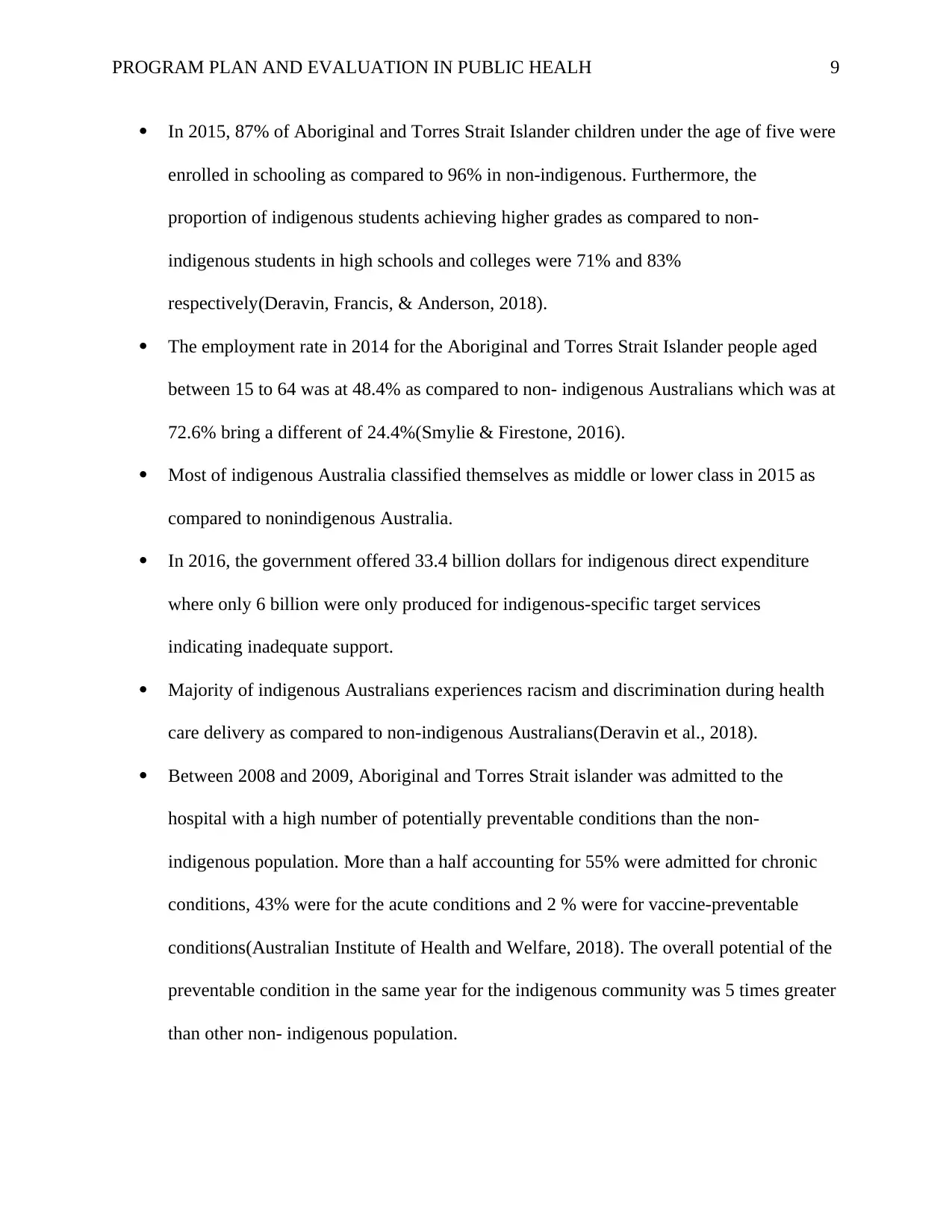
PROGRAM PLAN AND EVALUATION IN PUBLIC HEALH 9
In 2015, 87% of Aboriginal and Torres Strait Islander children under the age of five were
enrolled in schooling as compared to 96% in non-indigenous. Furthermore, the
proportion of indigenous students achieving higher grades as compared to non-
indigenous students in high schools and colleges were 71% and 83%
respectively(Deravin, Francis, & Anderson, 2018).
The employment rate in 2014 for the Aboriginal and Torres Strait Islander people aged
between 15 to 64 was at 48.4% as compared to non- indigenous Australians which was at
72.6% bring a different of 24.4%(Smylie & Firestone, 2016).
Most of indigenous Australia classified themselves as middle or lower class in 2015 as
compared to nonindigenous Australia.
In 2016, the government offered 33.4 billion dollars for indigenous direct expenditure
where only 6 billion were only produced for indigenous-specific target services
indicating inadequate support.
Majority of indigenous Australians experiences racism and discrimination during health
care delivery as compared to non-indigenous Australians(Deravin et al., 2018).
Between 2008 and 2009, Aboriginal and Torres Strait islander was admitted to the
hospital with a high number of potentially preventable conditions than the non-
indigenous population. More than a half accounting for 55% were admitted for chronic
conditions, 43% were for the acute conditions and 2 % were for vaccine-preventable
conditions(Australian Institute of Health and Welfare, 2018). The overall potential of the
preventable condition in the same year for the indigenous community was 5 times greater
than other non- indigenous population.
In 2015, 87% of Aboriginal and Torres Strait Islander children under the age of five were
enrolled in schooling as compared to 96% in non-indigenous. Furthermore, the
proportion of indigenous students achieving higher grades as compared to non-
indigenous students in high schools and colleges were 71% and 83%
respectively(Deravin, Francis, & Anderson, 2018).
The employment rate in 2014 for the Aboriginal and Torres Strait Islander people aged
between 15 to 64 was at 48.4% as compared to non- indigenous Australians which was at
72.6% bring a different of 24.4%(Smylie & Firestone, 2016).
Most of indigenous Australia classified themselves as middle or lower class in 2015 as
compared to nonindigenous Australia.
In 2016, the government offered 33.4 billion dollars for indigenous direct expenditure
where only 6 billion were only produced for indigenous-specific target services
indicating inadequate support.
Majority of indigenous Australians experiences racism and discrimination during health
care delivery as compared to non-indigenous Australians(Deravin et al., 2018).
Between 2008 and 2009, Aboriginal and Torres Strait islander was admitted to the
hospital with a high number of potentially preventable conditions than the non-
indigenous population. More than a half accounting for 55% were admitted for chronic
conditions, 43% were for the acute conditions and 2 % were for vaccine-preventable
conditions(Australian Institute of Health and Welfare, 2018). The overall potential of the
preventable condition in the same year for the indigenous community was 5 times greater
than other non- indigenous population.
⊘ This is a preview!⊘
Do you want full access?
Subscribe today to unlock all pages.

Trusted by 1+ million students worldwide
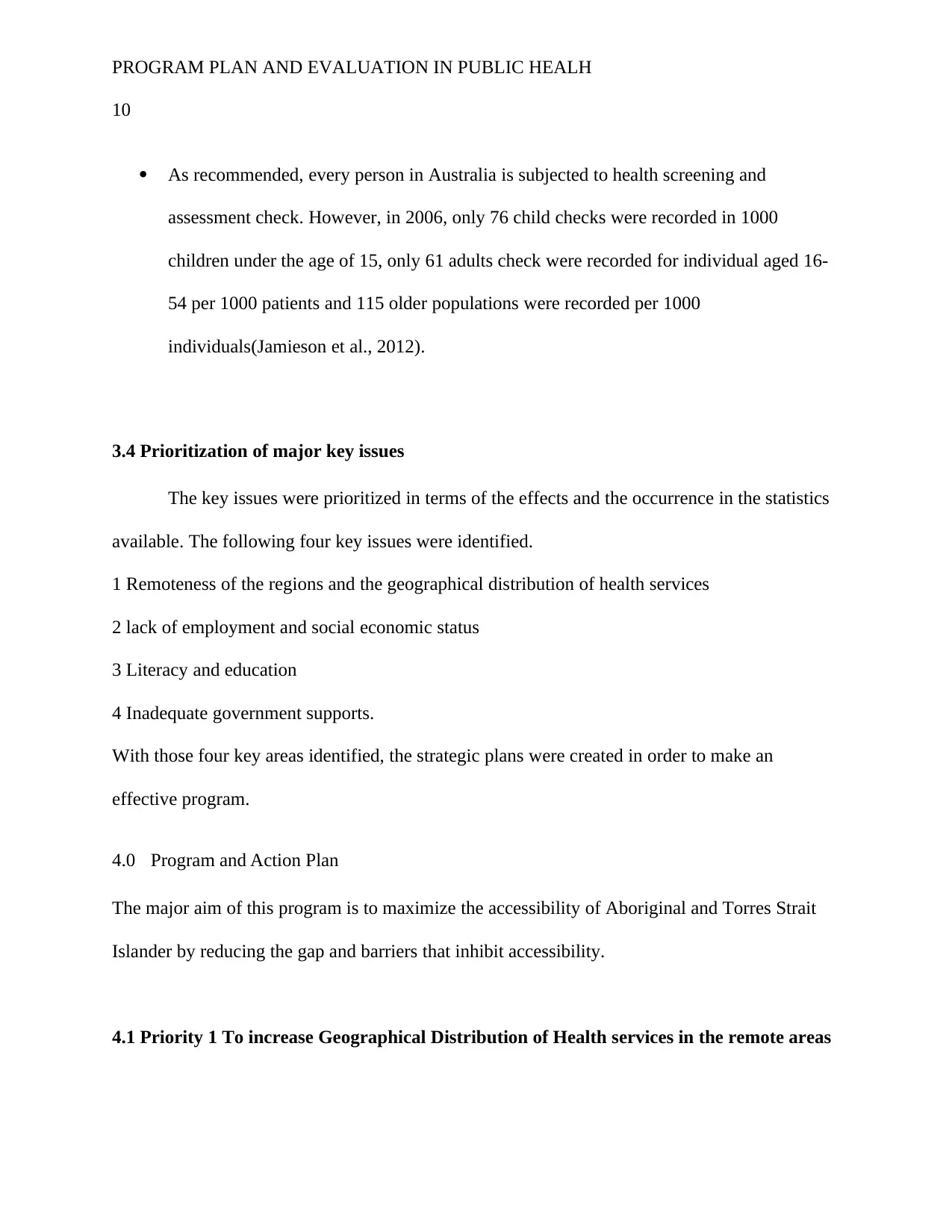
PROGRAM PLAN AND EVALUATION IN PUBLIC HEALH
10
As recommended, every person in Australia is subjected to health screening and
assessment check. However, in 2006, only 76 child checks were recorded in 1000
children under the age of 15, only 61 adults check were recorded for individual aged 16-
54 per 1000 patients and 115 older populations were recorded per 1000
individuals(Jamieson et al., 2012).
3.4 Prioritization of major key issues
The key issues were prioritized in terms of the effects and the occurrence in the statistics
available. The following four key issues were identified.
1 Remoteness of the regions and the geographical distribution of health services
2 lack of employment and social economic status
3 Literacy and education
4 Inadequate government supports.
With those four key areas identified, the strategic plans were created in order to make an
effective program.
4.0 Program and Action Plan
The major aim of this program is to maximize the accessibility of Aboriginal and Torres Strait
Islander by reducing the gap and barriers that inhibit accessibility.
4.1 Priority 1 To increase Geographical Distribution of Health services in the remote areas
10
As recommended, every person in Australia is subjected to health screening and
assessment check. However, in 2006, only 76 child checks were recorded in 1000
children under the age of 15, only 61 adults check were recorded for individual aged 16-
54 per 1000 patients and 115 older populations were recorded per 1000
individuals(Jamieson et al., 2012).
3.4 Prioritization of major key issues
The key issues were prioritized in terms of the effects and the occurrence in the statistics
available. The following four key issues were identified.
1 Remoteness of the regions and the geographical distribution of health services
2 lack of employment and social economic status
3 Literacy and education
4 Inadequate government supports.
With those four key areas identified, the strategic plans were created in order to make an
effective program.
4.0 Program and Action Plan
The major aim of this program is to maximize the accessibility of Aboriginal and Torres Strait
Islander by reducing the gap and barriers that inhibit accessibility.
4.1 Priority 1 To increase Geographical Distribution of Health services in the remote areas
Paraphrase This Document
Need a fresh take? Get an instant paraphrase of this document with our AI Paraphraser
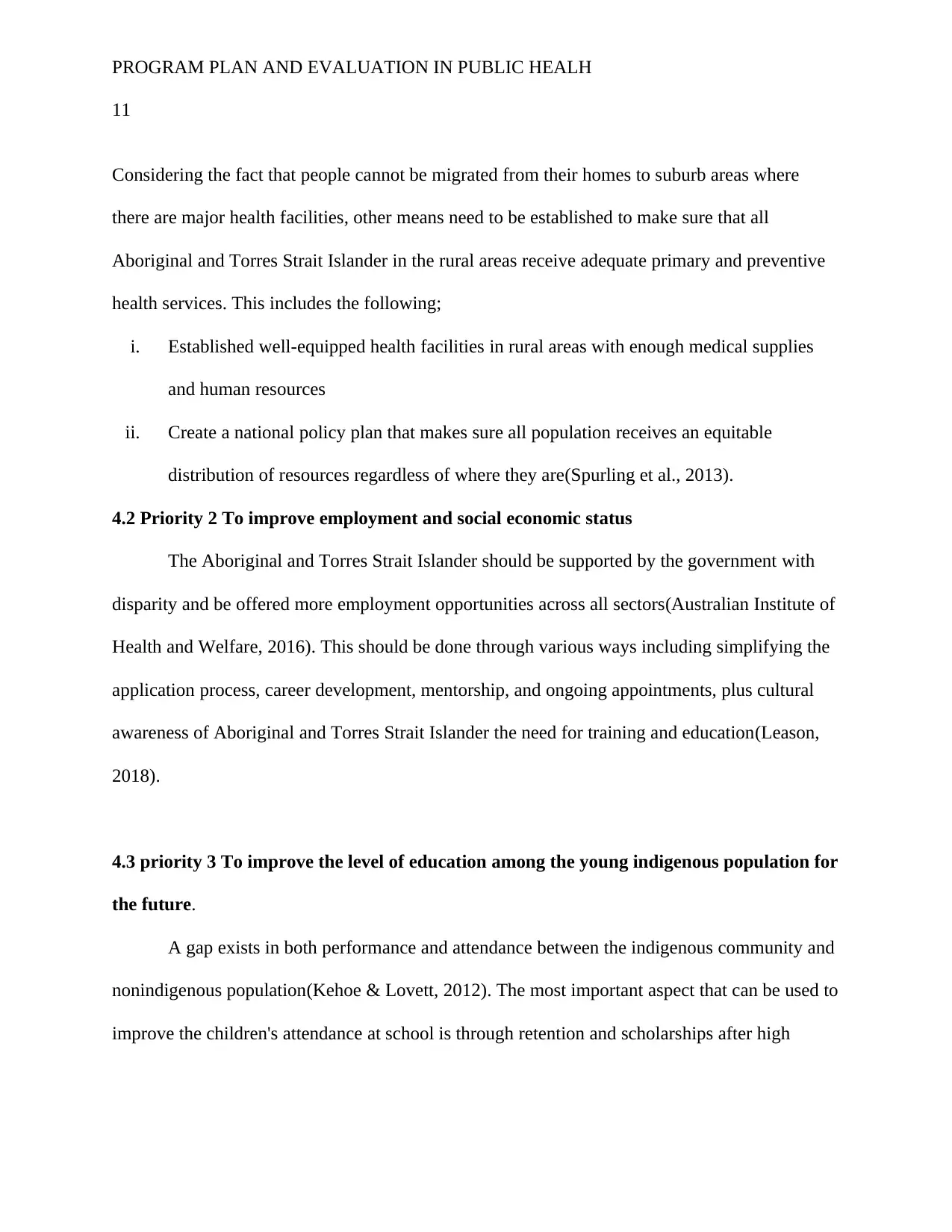
PROGRAM PLAN AND EVALUATION IN PUBLIC HEALH
11
Considering the fact that people cannot be migrated from their homes to suburb areas where
there are major health facilities, other means need to be established to make sure that all
Aboriginal and Torres Strait Islander in the rural areas receive adequate primary and preventive
health services. This includes the following;
i. Established well-equipped health facilities in rural areas with enough medical supplies
and human resources
ii. Create a national policy plan that makes sure all population receives an equitable
distribution of resources regardless of where they are(Spurling et al., 2013).
4.2 Priority 2 To improve employment and social economic status
The Aboriginal and Torres Strait Islander should be supported by the government with
disparity and be offered more employment opportunities across all sectors(Australian Institute of
Health and Welfare, 2016). This should be done through various ways including simplifying the
application process, career development, mentorship, and ongoing appointments, plus cultural
awareness of Aboriginal and Torres Strait Islander the need for training and education(Leason,
2018).
4.3 priority 3 To improve the level of education among the young indigenous population for
the future.
A gap exists in both performance and attendance between the indigenous community and
nonindigenous population(Kehoe & Lovett, 2012). The most important aspect that can be used to
improve the children's attendance at school is through retention and scholarships after high
11
Considering the fact that people cannot be migrated from their homes to suburb areas where
there are major health facilities, other means need to be established to make sure that all
Aboriginal and Torres Strait Islander in the rural areas receive adequate primary and preventive
health services. This includes the following;
i. Established well-equipped health facilities in rural areas with enough medical supplies
and human resources
ii. Create a national policy plan that makes sure all population receives an equitable
distribution of resources regardless of where they are(Spurling et al., 2013).
4.2 Priority 2 To improve employment and social economic status
The Aboriginal and Torres Strait Islander should be supported by the government with
disparity and be offered more employment opportunities across all sectors(Australian Institute of
Health and Welfare, 2016). This should be done through various ways including simplifying the
application process, career development, mentorship, and ongoing appointments, plus cultural
awareness of Aboriginal and Torres Strait Islander the need for training and education(Leason,
2018).
4.3 priority 3 To improve the level of education among the young indigenous population for
the future.
A gap exists in both performance and attendance between the indigenous community and
nonindigenous population(Kehoe & Lovett, 2012). The most important aspect that can be used to
improve the children's attendance at school is through retention and scholarships after high
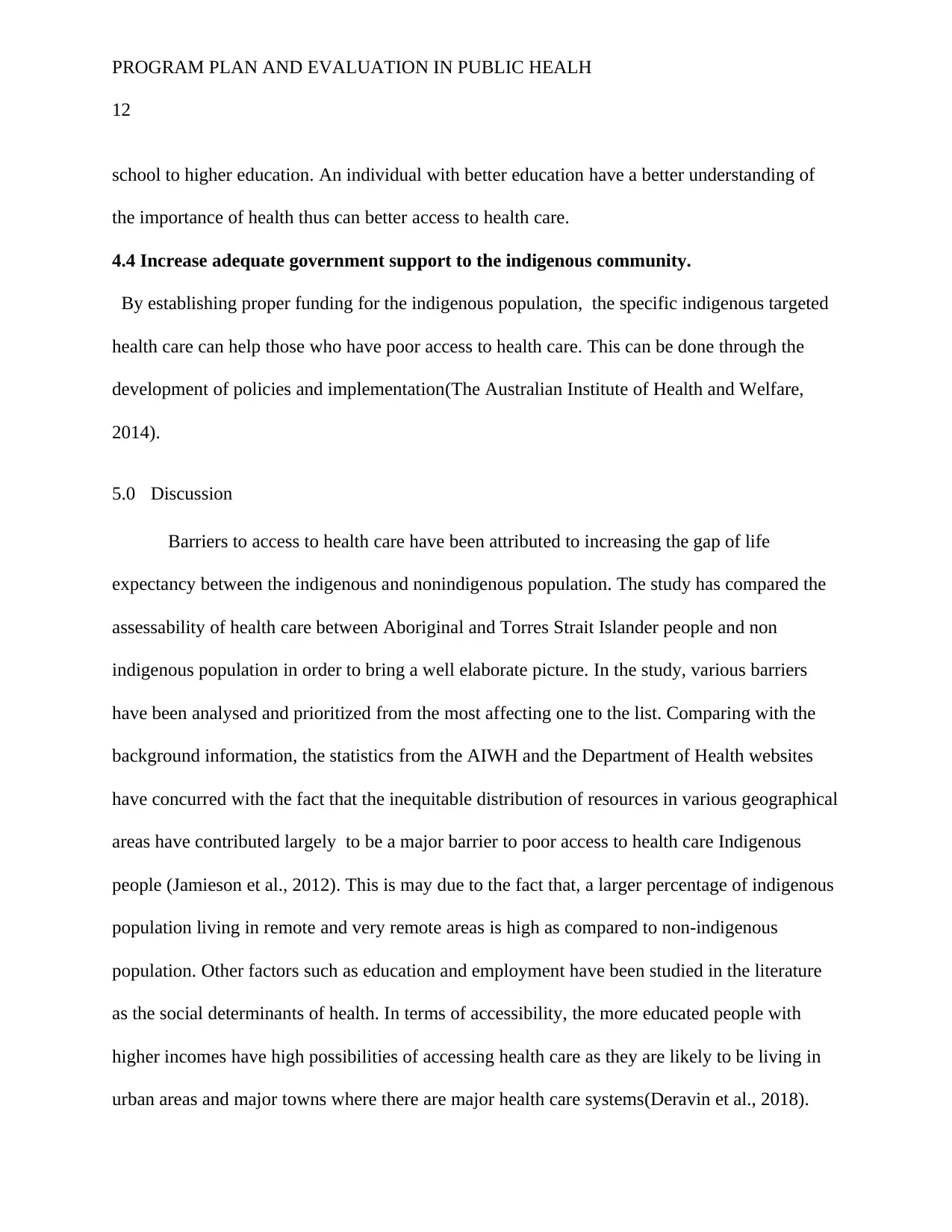
PROGRAM PLAN AND EVALUATION IN PUBLIC HEALH
12
school to higher education. An individual with better education have a better understanding of
the importance of health thus can better access to health care.
4.4 Increase adequate government support to the indigenous community.
By establishing proper funding for the indigenous population, the specific indigenous targeted
health care can help those who have poor access to health care. This can be done through the
development of policies and implementation(The Australian Institute of Health and Welfare,
2014).
5.0 Discussion
Barriers to access to health care have been attributed to increasing the gap of life
expectancy between the indigenous and nonindigenous population. The study has compared the
assessability of health care between Aboriginal and Torres Strait Islander people and non
indigenous population in order to bring a well elaborate picture. In the study, various barriers
have been analysed and prioritized from the most affecting one to the list. Comparing with the
background information, the statistics from the AIWH and the Department of Health websites
have concurred with the fact that the inequitable distribution of resources in various geographical
areas have contributed largely to be a major barrier to poor access to health care Indigenous
people (Jamieson et al., 2012). This is may due to the fact that, a larger percentage of indigenous
population living in remote and very remote areas is high as compared to non-indigenous
population. Other factors such as education and employment have been studied in the literature
as the social determinants of health. In terms of accessibility, the more educated people with
higher incomes have high possibilities of accessing health care as they are likely to be living in
urban areas and major towns where there are major health care systems(Deravin et al., 2018).
12
school to higher education. An individual with better education have a better understanding of
the importance of health thus can better access to health care.
4.4 Increase adequate government support to the indigenous community.
By establishing proper funding for the indigenous population, the specific indigenous targeted
health care can help those who have poor access to health care. This can be done through the
development of policies and implementation(The Australian Institute of Health and Welfare,
2014).
5.0 Discussion
Barriers to access to health care have been attributed to increasing the gap of life
expectancy between the indigenous and nonindigenous population. The study has compared the
assessability of health care between Aboriginal and Torres Strait Islander people and non
indigenous population in order to bring a well elaborate picture. In the study, various barriers
have been analysed and prioritized from the most affecting one to the list. Comparing with the
background information, the statistics from the AIWH and the Department of Health websites
have concurred with the fact that the inequitable distribution of resources in various geographical
areas have contributed largely to be a major barrier to poor access to health care Indigenous
people (Jamieson et al., 2012). This is may due to the fact that, a larger percentage of indigenous
population living in remote and very remote areas is high as compared to non-indigenous
population. Other factors such as education and employment have been studied in the literature
as the social determinants of health. In terms of accessibility, the more educated people with
higher incomes have high possibilities of accessing health care as they are likely to be living in
urban areas and major towns where there are major health care systems(Deravin et al., 2018).
⊘ This is a preview!⊘
Do you want full access?
Subscribe today to unlock all pages.

Trusted by 1+ million students worldwide
1 out of 19
Related Documents
Your All-in-One AI-Powered Toolkit for Academic Success.
+13062052269
info@desklib.com
Available 24*7 on WhatsApp / Email
![[object Object]](/_next/static/media/star-bottom.7253800d.svg)
Unlock your academic potential
Copyright © 2020–2025 A2Z Services. All Rights Reserved. Developed and managed by ZUCOL.





